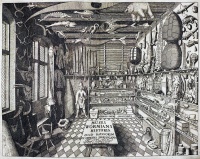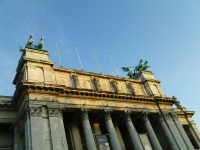Museum
From The Art and Popular Culture Encyclopedia
| Revision as of 19:00, 26 January 2012 Jahsonic (Talk | contribs) ← Previous diff |
Revision as of 20:54, 2 December 2013 Jahsonic (Talk | contribs) Next diff → |
||
| Line 1: | Line 1: | ||
| + | [[Image:KMSKA in September 2008, foto door J. W. Geerinck.jpg|thumb|right|200px|[[Royal Museum of Fine Arts Antwerp]]]] | ||
| [[Image:Musei Wormiani Historia.jpg|thumb|right|200px|"[[Musei Wormiani Historia]]", the [[book frontispiece|frontispiece]] from the ''Museum Wormianum'' depicting [[Ole Worm]]'s [[cabinet of curiosities]]]] | [[Image:Musei Wormiani Historia.jpg|thumb|right|200px|"[[Musei Wormiani Historia]]", the [[book frontispiece|frontispiece]] from the ''Museum Wormianum'' depicting [[Ole Worm]]'s [[cabinet of curiosities]]]] | ||
| {{Template}} | {{Template}} | ||
Revision as of 20:54, 2 December 2013

|
Related e |
|
Featured: |
A museum is a "permanent institution in the service of society and of its development, open to the public, which acquires, conserves, researches, communicates and exhibits, for purposes of study, education, enjoyment, the tangible and intangible evidence of people and their environment".
History
Early museums began as the private collections of wealthy individuals, families or institutions of art and rare or curious natural objects and artifacts. These were often displayed in so-called wonder rooms or cabinets of curiosities. Public access was often possible for the "respectable", especially to private art collections, but at the whim of the owner and his staff.
The first public museums in the world opened in Europe during the 18th century and the Age of Enlightenment:
- the Amerbach Cabinet, originally a private collection, was bought by the university and city of Basel in 1661 and opened to the public in 1671.
- the Royal Armouries in the Tower of London is the oldest museum in the United Kingdom. It opened to the public in 1660, though there had been paying privileged visitors to the armouries displays from 1592. Today the museum has three sites including its new headquarters in Leeds.
- the Musée des Beaux-Arts et d'archéologie in Besançon was established in 1694 after Jean-Baptiste Boisot, an abbot, gave his personal collection to the Benedictines of the city in order to create a museum open to the public two days every week.
- the Museo Sacro, the first museum in the Vatican Museums complex, was opened in Rome in 1756
- the British Museum in London, was founded in 1753 and opened to the public in 1759. Sir Hans Sloane's personal collection of curios provided the initial foundation for the British Museum's collection.
- the Uffizi Gallery in Florence, which had been open to visitors on request since the 16th century, was officially opened to the public 1765
- the Belvedere Palace of the Habsburg monarchs in Vienna opened with a collection of art in 1781
- Louvre in Paris France. The Mona Lisa Painting by Leonardo Da Vinci resides in the Louvre.
These "public" museums, however, were often accessible only by the middle and upper classes. It could be difficult to gain entrance. In London for example, prospective visitors to the British Museum had to apply in writing for admission. Even by 1800 it was possible to have to wait two weeks for an admission ticket. Visitors in small groups were limited to stays of two hours. In Victorian times in England it became popular for museums to be open on a Sunday afternoon (the only such facility allowed to do so) to enable the opportunity for "self improvement" of the other - working - classes.
The first truly public museum was the Louvre Museum in Paris, opened in 1793 during the French Revolution, which enabled for the first time in history free access to the former French royal collections for people of all stations and status. The fabulous art treasures collected by the French monarchy over centuries were accessible to the public three days each "décade" (the 10-day unit which had replaced the week in the French Republican Calendar). The Conservatoire du muséum national des Arts (National Museum of Arts's Conservatory) was charged with organizing the Louvre as a national public museum and the centerpiece of a planned national museum system. As Napoléon I conquered the great cities of Europe, confiscating art objects as he went, the collections grew and the organizational task became more and more complicated. After Napoleon was defeated in 1815, many of the treasures he had amassed were gradually returned to their owners (and many were not). His plan was never fully realized, but his concept of a museum as an agent of nationalistic fervor had a profound influence throughout Europe.
American museums eventually joined European museums as the world's leading centers for the production of new knowledge in their fields of interest. A period of intense museum building, in both an intellectual and physical sense was realized in the late 19th and early 20th centuries (this is often called "The Museum Period" or "The Museum Age"). While many American museums, both Natural History museums and Art museums alike, were founded with the intention of focusing on the scientific discoveries and artistic developments in North America, many moved to emulate their European counterparts in certain ways (including the development of Classical collections from ancient Egypt, Greece, Mesopotamia and Rome). Universities became the primary centers for innovative research in the United States well before the start of the Second World War. Nevertheless, museums to this day contribute new knowledge to their fields and continue to build collections that are useful for both research and display.
See also


